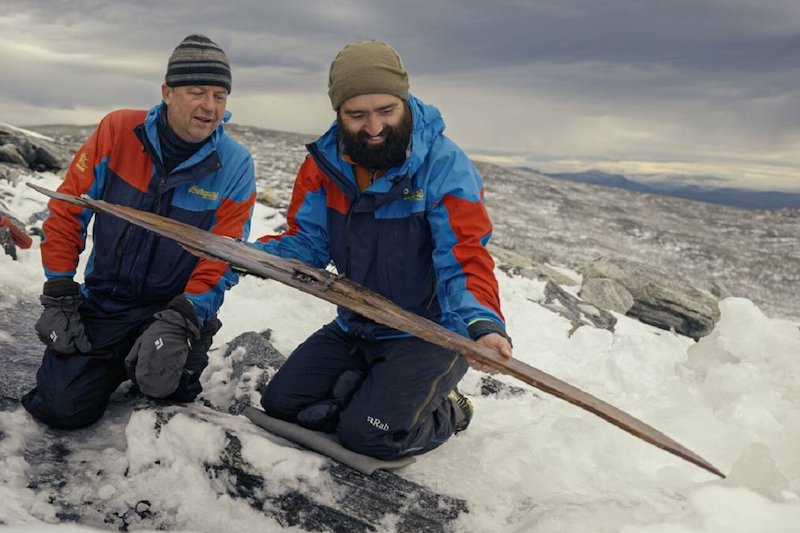In the heart of southern Norway’s Digervarden Mountain, a groundbreaking discovery unfolded as archaeologists unearthed the second piece of a 1,300-year-old wooden ski pair. This revelation comes seven years after the initial find, revealing one of the best-preserved ancient skis to date.
The Journey Unfolds
Back in 2014, researchers stumbled upon a single wooden ski embedded in the ice at Digervarden Mountain. Fast forward to today, and they have finally unearthed its companion. The newly rescued ski boasts better preservation, possibly attributed to a deeper burial within the ice, as suggested by Lars Pilø, an archaeologist from the Glacier Archaeology Program (GAP) in Norway.

Measuring approximately 185 cm in length and 17 cm in width, the second ski is slightly larger than its mate. Both skis feature raised foot placements, accompanied by leather straps and bindings made from twisted birch bark, likely fastened into holes at the foot placements. Signs of wear and ultimate repairs adorn the newly found ski.
Pilø remarks, “These skis aren’t identical, but we shouldn’t expect them to be. They are handmade, not mass-produced. An Iron Age skier meticulously crafted them over a considerable period before they ultimately found their way into the ice.”
Insights from Melting Glaciers
As climate change accelerates glacier melting, archaeologists, including Daniel Burgess from GAP, unveil more clues about ancient life in icy regions, including parts of Norway. Discoveries in the southern Norwegian mountains affirm the connections between Viking-era inhabitants and the outside world.
Pilø emphasizes, “The findings demonstrate that the high mountains of southern Norway weren’t isolated regions devoid of external contact.”
Since the discovery of the first ski, archaeologists have been monitoring the region using satellite imagery and a face-to-face survey conducted in 2016. Pilø notes, “This year, we observed the retreat of the ice piece in satellite images compared to 2014.”
A Challenging Retrieval
On September 20th, two researchers visited the site and located the second ski approximately 15 meters away from the original find, firmly stuck in the ice. When a larger team with additional equipment reached the area, new snow had covered the region. Fortunately, using GPS data and photos, the team successfully located the second ski again. After clearing the area with a snow shovel, they employed an ice pick and warm water to extract the ski.

The Digervarden ice piece had previously revealed artifacts and monuments related to reindeer hunting, along with several mounds that could be associated with an ancient mountain route. Researchers speculate that the owner of the skis may have been a hunter, traveler, or both.
Older Counterparts
Following the discovery of the first ski, researchers pondered whether the underside of ancient skis, like some older counterparts, was once covered in fur. The newly found ski resolves this mystery, displaying a groove beneath, similar to those found in other ancient and modern skis. If covered with fur, this groove would serve no purpose, leading researchers to believe that these skis were devoid of fur.
Skiing Through the Ages
Historically, hunters in Europe and Asia began using skis for hunting at the end of the last Ice Age. Controversial evidence of skiing in China dates back to around 8000 BCE, while the oldest confirmed ski found in Russia dates back to approximately 6000 BCE. Archaeologists in Scandinavia have uncovered wooden skis and ski-like artifacts dating back to 3200 BCE.
In June, Pilø and colleagues announced the discovery of a centuries-old beeswax and a tunic made of lamb wool dating back to 300 CE in the Lendbreen glacier.



